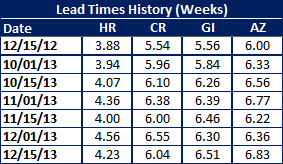SMU Data and Models

Mill Lead Times & Mill Negotiations: Still Tight (signs of loosening?)
Written by John Packard
December 19, 2013
Lead times continue to be longer than normal with hot rolled averaging more than 4 weeks (4.23 weeks), cold rolled exceeding 6 weeks (6.04 weeks), galvanized at 6.51 weeks and Galvalume averaging 6.83 weeks. All of the flat rolled steel lead times measured this week are extended compared to last year during the middle of December. Our survey respondents are reporting galvanized as having the biggest change compared to last year having added a full week to its average.

As we approach the end of the year we are capturing some movement in hot rolled as our survey respondents reported the domestic mills as being more willing to negotiate HRC than they were just two weeks ago (56 percent vs. 41 percent). All of the other items had increases in negotiations but the continued to be relatively modest adjustments.


John Packard
Read more from John PackardLatest in SMU Data and Models

SMU Survey: Sheet lead times ease further, plate hits one-year high
Steel buyers responding to this week’s SMU market survey report a continued softening in sheet lead times. Meanwhile, plate lead times have moderately extended and are at a one-year high.

SMU Survey: Buyers report more price flexibility from mills
Nearly half of the steel buyers responding to this week’s SMU market survey say domestic mills are showing increased willingness to negotiate pricing on new spot orders. This marks a significant shift from the firmer stance mills held in prior weeks.

SMU Survey: Buyers’ Sentiment Indices fall
Current Sentiment Index dropped six points to +42 this week compared to two weeks earlier. It has fallen in every successive survey since reaching a 2025 high of +66 on Feb. 19.

March service center shipments and inventories report
Steel service center shipments and inventories report through March 2024.

Apparent steel supply contracts in February
The amount of finished steel that entered the US market in February receded from January’s peak, according to our analysis of Department of Commerce and American Iron and Steel Institute (AISI) data.
